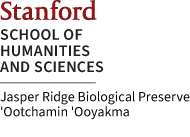Invasive Species
Jasper Ridge is easily thought of as a natural history oasis within the urban/wildland interface, an island in a sea of increasing human development. As a result, the preserve faces many management challenges that include important questions about how the consequences of its insularity will impact its rich biodiversity and how best to sustain it’s many natural characteristics now and into the forseeable future.
Like most open space preserves and Mediterranean ecosystems, invasive species present a threat to its ecosystems. These threats are partly mitigated by providing unique opportunities to answer important questions ecological questions. Like many other biological field stations, the preserve must balance how to manage invasive species with the many important questions their presence can be used to help answer. In recent years, students and researchers have published a half dozen dissertations and over 20 journal publications focusing on the dynamics of invasive species with other organisms and ecosystem functions.
As a biological field station, Jasper Ridge must approach management of invasive species with an appreciation of how management activities can influence the kinds of studies and questions that may be precluded or enhanced by management practices. For instance, preserve’s insularity and the presence of invasive species provide a setting to address important issues about whether biological corridors help sustain biodiversity or become a means to further disperse invasive species into natural areas. Efforts to manage such corridors or the spread of a particular non-native species precludes understanding the processes at work that determine whether a corridor enhance native biodiversity or the spread of non-native species.
Directing resources to manage particular non-native species also requires that we understand to what degree climate change is a player in the presence and spread of invasive species. To the degree that climate change becomes a driver suggests changing adaptive conditions that suggest that resources directed at managing particular invasives may be fruitless.
Other important questions related to the presence and spread of non-native species include: What types of ecosystem functions will invasive species disrupt or displace? What is the role of biodiversity in resisting invasion and what are the most important characteristics of biodiversity that enhance ecosystem resistance to invasion? How should we decide which invasive species to focus management efforts and how do we know when management is best exercised with the lightest touch or may require long, sustained manipulation? Do native pathogens play a role in the spread of non-native species, and if so, what is the nature of that role?
At Jasper Ridge, research on invasive species has tended to focus on Argentine ants (Linopithema humile) and yellow starthistle (Centaurea solstitialis). Other, recent non-native species that have arrived to Jasper Ridge that may present both management challenges and research opportunities include:
Common black ground beetle (Pterostichus melanarius)
Gray garden slug (Deroceras reticulatum)
Slender false brome (Brachypodium sylvaticum)
Stinkweed (Dittrichia graveolens)
Sudden Oak Death (Phytophthera ramorum)
Tramp ant (Cardiocondyla mauritanica)
Turkeys (Meleagris gallopavo)
West Nile Virus (Flavivirus spp.)
These and other new arrivals will continue to challenge management efforts to protect the preserve’s natural heritage while also providing new opportunities for important research.



